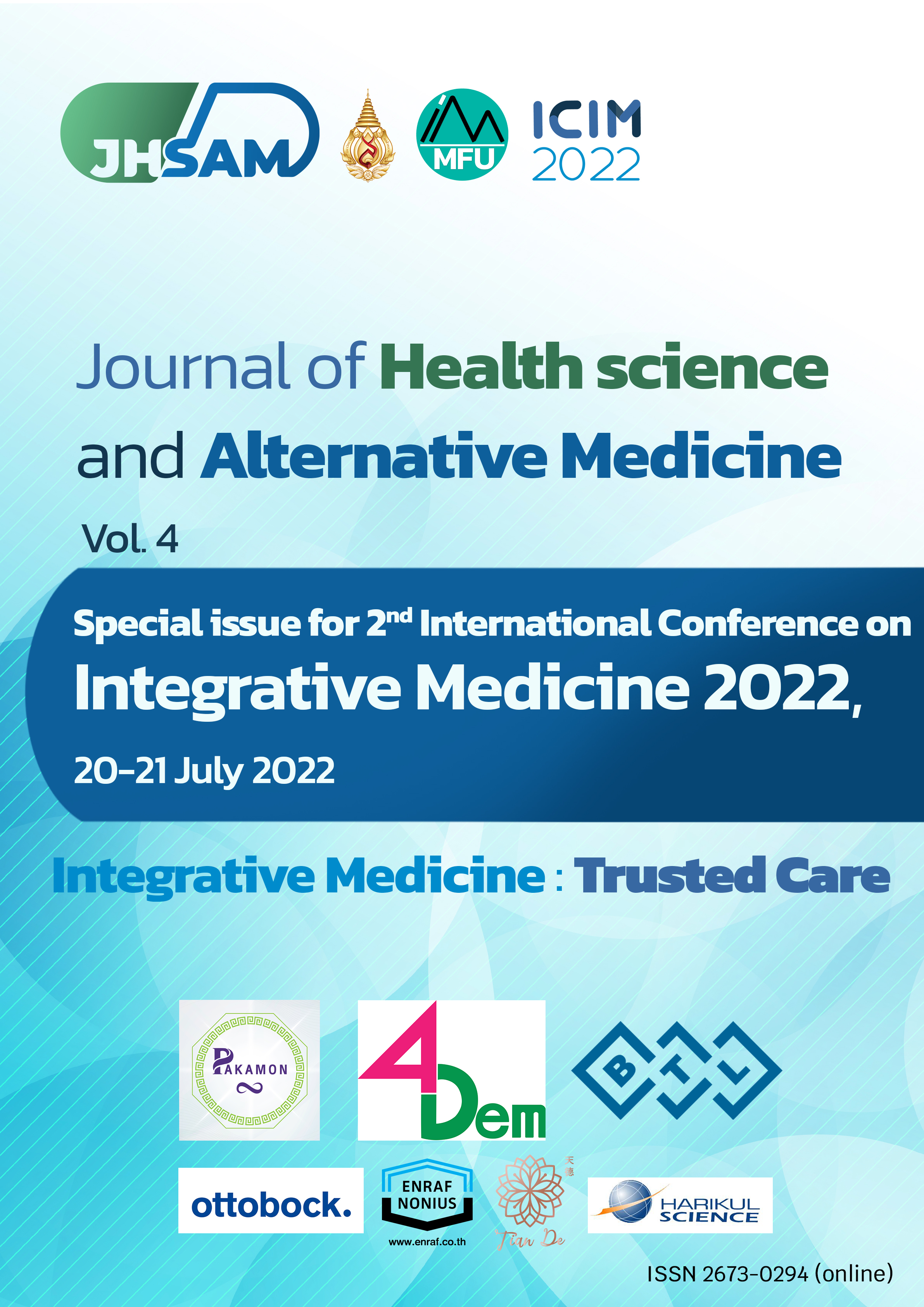C16. Correlation between the 2- and 6- minute Walk Test in Healthy Children Aged 7-10 Years
Main Article Content
Abstract
Introduction: The 2- and 6-minute walk tests are used to assess walking ability, but the 2-minute walk test is not commonly known.
Objective: The purpose of the research was to investigate the correlation between the 2- and 6-minute walk tests in healthy children.
Methods: A Cross-sectional study was carried out on healthy children whose age ranged from 7 to 10 in the first through third grades of primary schools in Chiang Mai province, Northern Thailand. Each participant also completed a 2- and 6-minute walk test on two separate test days by a week. Pearsons’ correlation coefficient (r) was calculated for the relationship between 2- and 6-minute walk test.
Results: In 2- and 6-minute walk tests, the mean walking distance was 203.6 meter from the 2-minute walk test and 559.79 meter form 6-minute walk test. A significant positive correlation was found between 2- and 6-minute walk tests, r =0.99, p = 0.001 of all participants.
Conclusion: These data suggest that the 2- and 6-minute walk tests in healthy children have fairly strong positive correlation. Our findings support the 2-minute walk test is a suitable alternative timed walking test for functional capacity testing in children.
Article Details

This work is licensed under a Creative Commons Attribution-NonCommercial-NoDerivatives 4.0 International License.
JHSAM publishes all articles in full open access, meaning unlimited use and reuse of articles with appropriate credit to the authors.
All our articles are published under a Creative Commons "CC-BY-NC-ND 4.0". License which permits use, distribution and reproduction in any medium,
provided that the original work is properly cited and is used for noncommercial purposes.
References
Mitchell C. Pedestrian mobility and safety. A key to independence for older people. Topics in Geriatric Rehabilitation. 2006;22:45-52.
Shumway-Cook A, Patla AE, Stewart A, Ferrucci L, Ciol MA, Guralnik JM. Environmental demands associated with community mobility in older adults with and without mobility disabilities. Phys Ther. 2002;82(7):670-81.
McGavin CR, Gupta SP, McHardy GJ. Twelve-minute walking test for assessing disability in chronic bronchitis. Br Med J. 1976;1(6013):822-3.
Beydon N, Davis SD, Lombardi E, Allen JL, Arets HG, Aurora P, et al. An official American Thoracic Society/European Respiratory Society statement: pulmonary function testing in preschool children. Am J Respir Crit Care Med. 2007;175(12):1304-45.
Cacau LA, de Santana-Filho VJ, Maynard LG, Gomes MN, Fernandes M, Carvalho VO. Reference Values for the Six-Minute Walk Test in Healthy Children and Adolescents: a Systematic Review. Braz J Cardiovasc Surg. 2016;31(5):381-8.
Knak KL, Andersen LK, Witting N, Vissing J. Reliability of the 2- and 6-minute walk tests in neuromuscular diseases. J Rehabil Med. 2017;49(4):362-6.
Bohannon RW, Wang YC, Bubela D, Gershon RC. Normative Two-Minute Walk Test Distances for Boys and Girls 3 to 17 Years of Age. Phys Occup Ther Pediatr. 2018;38(1):39-45.
Vill K, Ille L, Schroeder SA, Blaschek A, Müller-Felber W. Six-minute walk test versus two-minute walk test in children with Duchenne muscular dystrophy: Is more time more information? Eur J Paediatr Neurol. 2015;19(6):640-6.
Pin TW, Choi HL. Reliability, validity, and norms of the 2-min walk test in children with and without neuromuscular disorders aged 6-12. Disabil Rehabil. 2018;40(11):1266-72.
Tonklang N, Roymanee S, Sopontammarak S. Developing standard reference data for Thai children from a six-minute walk test. J Med Assoc Thai. 2011;94(4):470-5.
Holland AE, Spruit MA, Troosters T, Puhan MA, Pepin V, Saey D, et al. An official European Respiratory Society/American Thoracic Society technical standard: field walking tests in chronic respiratory disease. Eur Respir J. 2014;44(6):1428-46.
Bohannon RW, Wang YC, Gershon RC. Two-minute walk test performance by adults 18 to 85 years: normative values, reliability, and responsiveness. Arch Phys Med Rehabil. 2015;96(3):472-7.
Wang TJ, Chau B, Lui M, Lam GT, Lin N, Humbert S. Physical Medicine and Rehabilitation and Pulmonary Rehabilitation for COVID-19. Am J Phys Med Rehabil. 2020;99(9):769-74.


